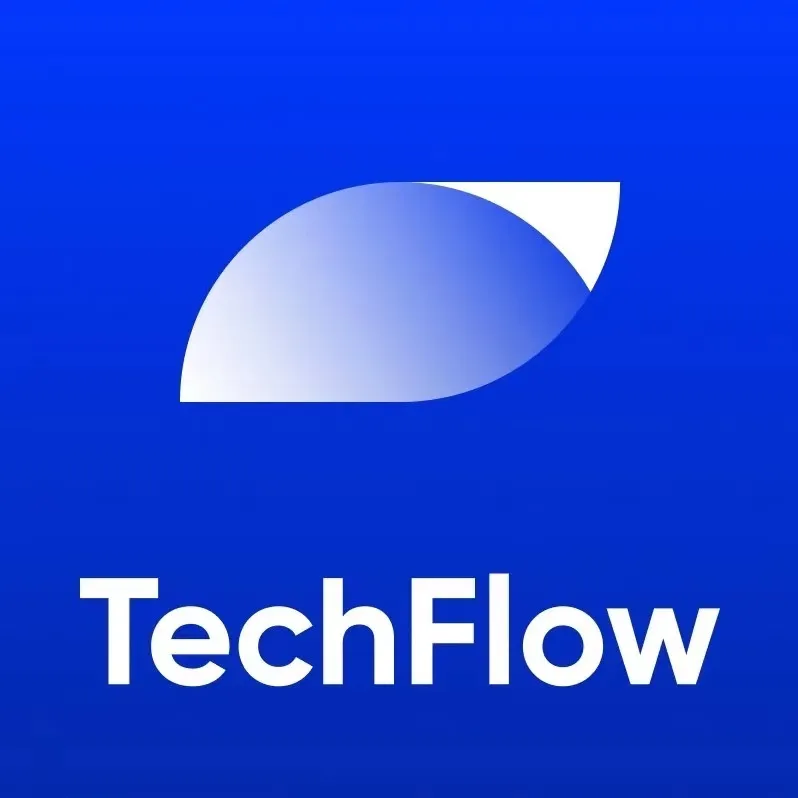From Cradle to Unicorn: The Cycle Theory of Ethereum Public Goods Financing
Original Title: “Cradle-to-unicorn public goods funding”
Authors: Carl Cervone, Kevin Owocki
Compiled by: Pure, Deep Tide TechFlow
Editor's Note: Carl Cervone, a member of the Open Source Observer team, and Kevin Owocki, co-founder of Gitcoin, co-authored this article to dissect the funding cycle of public goods in the Ethereum ecosystem, as well as the problems and opportunities that exist within each cycle. This article provides a foundational framework for the periodic study of public goods, with the mentioned opportunities serving as valuable references for building directions.
TLDR
This article discusses the end-to-end funding lifecycle of Ethereum public goods;
We believe that addressing these issues can create sustainable competitive advantages for the cryptocurrency ecosystem;
We outline the lifecycle of public goods funding:
The cradle stage focuses on building and obtaining initial funding;
The maturity stage includes community building and surviving in the "valley of sadness";
The unicorn stage is about achieving significant impact and obtaining retrospective funding.
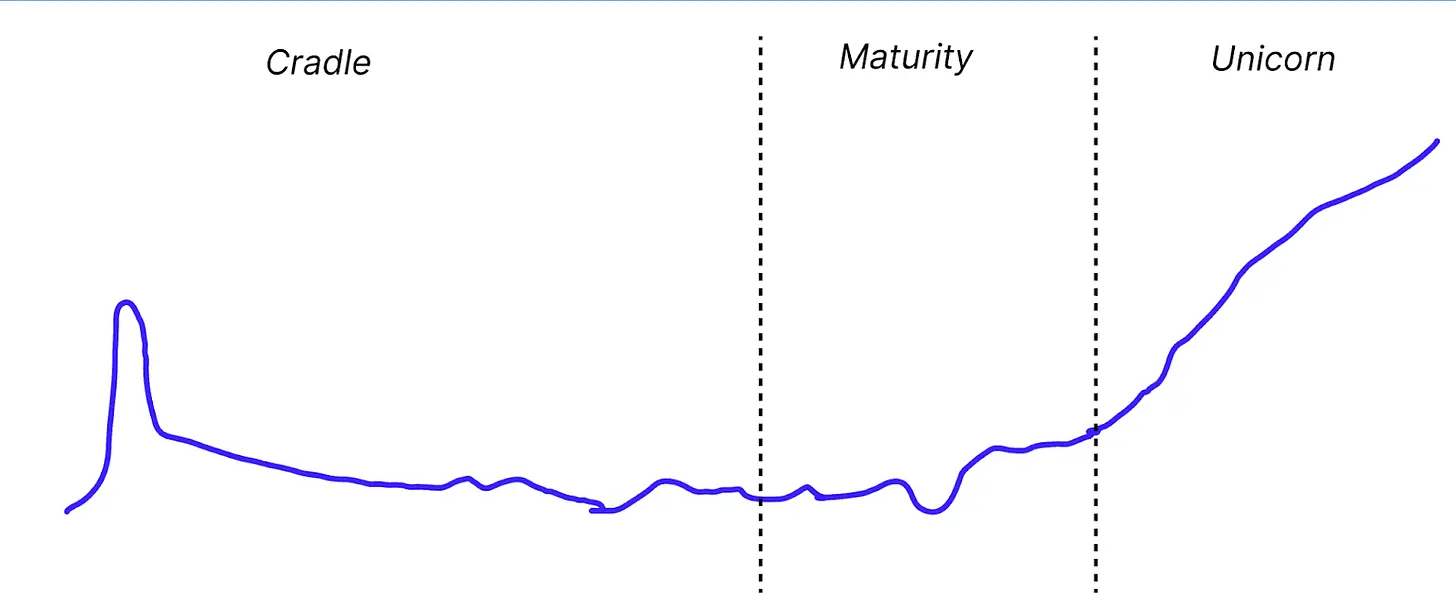
Private Goods Funding Project Lifecycle
There is a famous chart that illustrates the lifecycle of a startup: from being first reported by TechCrunch, to gradually losing its novelty, to a long "valley of sadness," and finally crossing the chasm to be sold for billions of dollars.
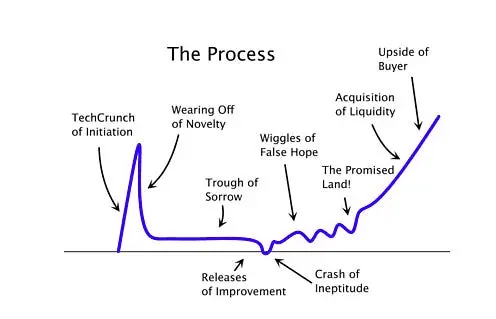
These types of startups are typically funded by venture capital firms. Most of them die in the valley because they run out of funds before finding product-market fit.
The funding infrastructure for startups is quite well established: they receive some initial venture capital to build products around their ideas; if they enter the growth stage, they receive more venture capital (and revenue); ultimately, if all goes well, everyone will reap huge returns from their invested funds when the company experiences a liquidity event.
Additionally, there is a value chain composed of different funders who specialize in funding different types and stages of startups. Early investors are often very different from late-stage investors. Early investors mostly bet on people, so they need specialized domain knowledge and networks to find good deals. Late-stage investors focus more on numbers, so they closely monitor the company's metrics and macro conditions. Investors in this space can provide valuable resources, including education, recruitment, mentorship, and more.
Public Goods Funding Project Lifecycle
Let’s consider what a similar funding lifecycle chart for Ethereum public goods might look like, ideally providing funding before, during, and after the team makes an impact.
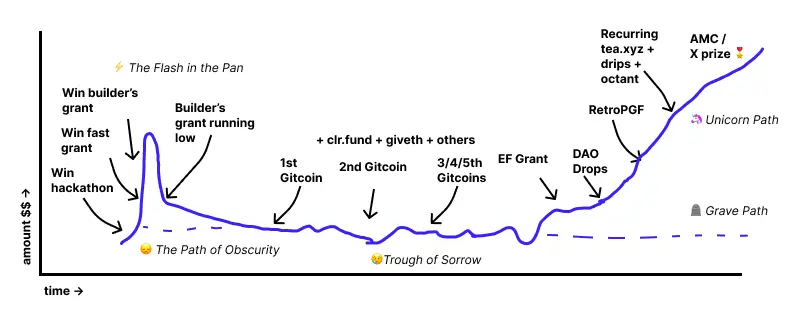
To accelerate innovation, every viable project should receive funding during the "from cradle to unicorn" phase of the public goods organization lifecycle.
Moreover, continuous funding, validation, and other resources are needed to help projects navigate the "valley of sadness" from initial construction to becoming unicorns. Not all projects will succeed. In fact, most projects will not. If a project ultimately fails, and the team moves on, we should not feel ashamed (we should especially encourage sharing the lessons learned by these teams to prevent future teams from making the same mistakes).
1. Cradle: Potential Funding Stage
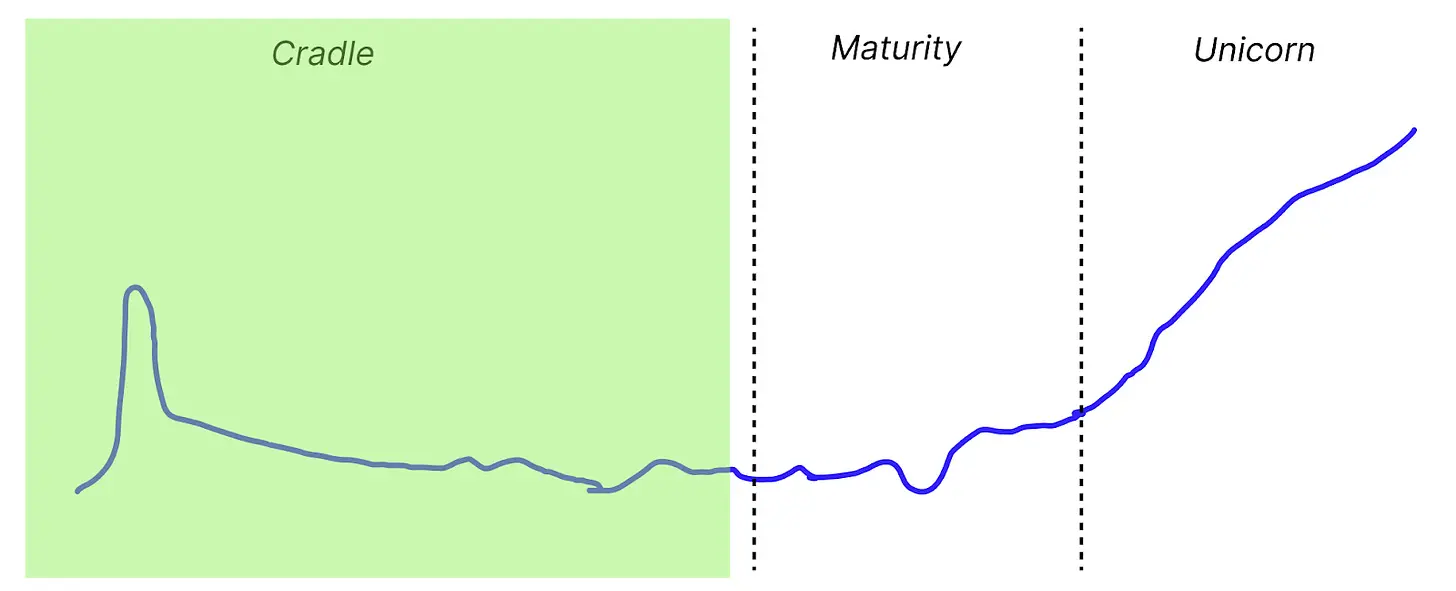
In the startup phase (early to mid-stage in the above image), funding is needed to reduce the upfront costs of entrepreneurship. People are afraid to quit their jobs, and applying for many grant programs is both difficult and time-consuming.
However, funding cannot be provided without scrutiny. To truly help builders, they also need to validate what can create value for how many people. While obtaining funding, it is also necessary to validate whether your work is important.
Bounties and hackathons are great ways to seed ideas, but they are unpredictable and can lead teams to constantly switch projects or jump ecosystems. There should be better pathways, perhaps with a few medium-sized quick grants in between winning a few small hackathons and receiving a large grant. This would help more projects get started and provide a smoother path for proven builders to quit their jobs and work full-time on their projects. It also helps keep builders focused on a specific ecosystem rather than jumping from one grant to another.
In the cradle stage, projects should focus on the most important thing: building. They should build in public as much as possible. Anything that can simplify their lives and help them focus on building/learning, whether it's finding insurance or hiring a good smart contract auditor, is worth it. Ideally, they should not spend too much time worrying about where the next funding will come from.
In our diagram, this stage starts with winning a hackathon and ends with receiving a small grant from the Ethereum Foundation. They have not yet made any real impact, but they have proven themselves worthy of substantial potential funding to build something.
2. Maturity: Community Funding Stage
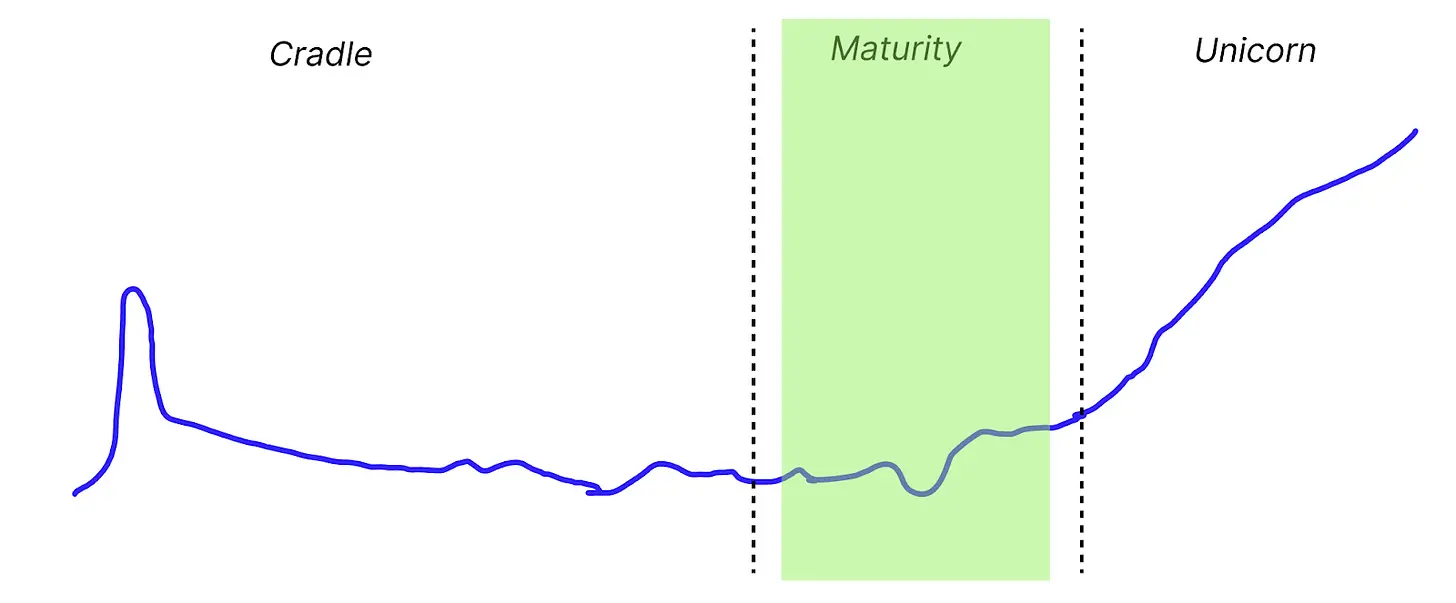
Now the project has some funding, but it is not running very well. It is building and trying different things, but often no one really cares yet.
The "valley of sadness" is like a bear market for projects. When your "valley of sadness" coincides with a funding bear market, it becomes even harder.
To survive the "valley of sadness" and grow into a mature public goods project, you need to build a community and start making a real, demonstrable impact on these people. This is the most valuable stage for community funding mechanisms like quadratic funding and direct grants.
While most projects may not raise $100,000 this way, they should be able to secure enough funding to survive and continue to develop. These mechanisms force projects to stay closely connected with the community and raise community awareness.
The best-performing projects in Gitcoin Grants are those that already exist and have built a reputation, rather than those that announce their existence to the world through Gitcoin. We have observed the same with other funding platforms, including clr.fund and Giveth.
The best projects mature during this stage, gaining a good reputation in the community for providing useful public goods.
3. Unicorn: Retrospective Funding Stage

At some point, a project will reach a tipping point where the impact it has on the ecosystem far exceeds the fair compensation it receives. We hope this is where a lot of retrospective funding comes into play.
Ideally, we will start to see various complementary mechanisms providing funding for these projects. Staking yields from ETH or profits from ETFs (like Van Eck) will grant to reputable projects. Increasing rounds of Optimism RetroPGF will be decided by a group of badge holders.
Currently, these are mostly technical mechanisms, but over time, public goods projects are expected to generate more bottom-up recurring revenue. tea.xyz and Drips v2 offer different ways to combine funding. This idea can be extended to any form of public goods. The better we get at tracking impact and creating rewards for upstream impacts, the more likely it is to become a viable source of recurring revenue for public goods projects.
Finally, it would be exciting to establish awards equivalent to the X Prize or large Advance Market Commitments (AMC) for public goods.
4. Death (Sometimes) is a Feature, Not a Bug

Many projects fail to achieve sustainability and do not become unicorns, but rather die in the process. In some cases, this is a feature, not a bug.
When a project fails, it can provide valuable lessons for entrepreneurs, investors, and the broader community. One of the main lessons is the importance of market demand: many projects fail because the products or services they create do not meet strong demand. This highlights the need for comprehensive market research and ongoing customer feedback. A failed project can also underscore the importance of timing. Even the most creative ideas need to be presented when market demand begins to emerge.
Another key lesson is the importance of flexibility and adaptability. Projects often operate in rapidly changing environments, and the ability to adjust based on market changes, customer feedback, or technological advancements is crucial for a project's survival. Failure also teaches us the importance of team dynamics and leadership. A common reason for project failure is internal conflict or a lack of clear leadership and vision. Therefore, building a strong, cohesive team aligned with the startup's goals is as important as the idea itself.
As builders of the ecosystem, the most important things are:
If a project is on the right path, do not let it die due to lack of funding;
If builders are on the wrong path, accelerate the path to death/reflection/revival;
If a project ultimately fails, the team should continue to move on, and this should not be a source of shame. We should especially encourage sharing these teams' lessons learned so that future teams do not make the same mistakes.
5. Not Every Successful Project is a Unicorn
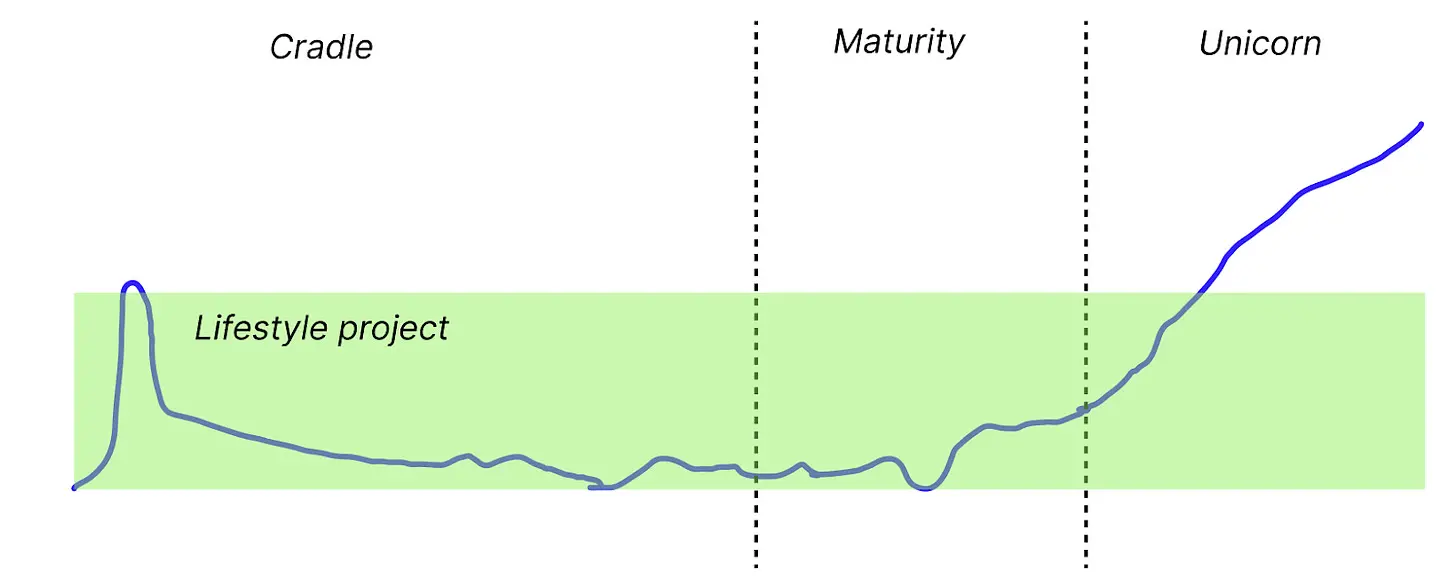
Perhaps "unicorn or death" is the wrong framework. Many projects do not aspire to become unicorns. In fact, the worship of unicorns is a remnant of the venture capital model, where the entire process hinges on finding a 100x exit opportunity to return all your funds.
There needs to be a lifestyle and business model for public goods—opportunities to build smaller-scale tools that can provide immense value but will never achieve exponential growth—i.e., change the world or become unicorns.
Suggestions and Open Questions
1. Keep Growing the Pie
One similarity we can draw from venture capital/startups is that successful founders can become the next generation of investors.
We can see contemporary unicorn companies providing funding for the next generation of public goods projects in their cradle stage. This is already happening, with projects like 1inch and Uniswap transitioning from Gitcoin Grant recipients to matching pool donors and donors to Protocol Guild. This should be encouraged at the societal level.
We can provide funding for the next generation of projects by creating credible crypto commitments that enhance societal motivation. If every new project funded in the cradle stage publishes an EAS proof indicating they plan to allocate 5% of their tokens to the next generation of projects, this creates a quantifiable future commitment for public goods funding.
Opportunities:
If the next generation of builders becomes unicorns, how do we attract them to make highly credible commitments to give back to public goods?
How do we launch a social movement to make this a trend?
How do we aggregate these commitments to make credible promises for future funding?
2. RetroPGF Provides Opportunities Around "Impact = Profit"
VCs push startups to accelerate and capture as much value as possible. The push for public goods should be to create as much value for the ecosystem as possible.
Retrospective public goods funding provides an opportunity to drive a different value capture mechanism that aligns with the "impact = profit" model.
By introducing retrospective public goods funding into the ecosystem, we can create a reliable monetary return commitment for public goods that generate the most impact. Because retrospective assessments are easier to judge project quality than expected, retrospective funding is closer to "impact = profit."
This way, future public goods funders can change the early steps of the funding lifecycle. Speculators can speculate on which public goods are most likely to receive retrospective returns later. Tools that allow users to "angel invest" in public goods early in the cycle may facilitate this development.
Another opportunity is to create impact proofs that credibly track which projects generate the most impact. These large-scale impact proofs will form a trust network that allows all projects to demonstrate each other's impact. Tools like EAS and Hypercerts can provide the foundation for these impact proofs. As whale funders use these tools as signal detection to decide which projects to fund, they become increasingly valuable, and they can also serve as valuable tools for builders to understand if they are on the right path.
Opportunities:
Incorporate Hypercerts/EAS into existing public goods funding projects
Establish new impact proof services to help people distinguish which projects are impactful
Create new forward-looking public goods funding tools to obtain future retrospective rewards.
3. Surviving the Cradle Stage
Creating a reliable pathway to survive the cradle stage is one of the most important unresolved issues in this field.
Open questions here include:
If a builder fails to attract funding/validation, is it because the ecosystem has issues, or because the builder has not found a significant enough problem area worth funding?
What kind of safety net do public goods builders particularly need? Reverse thinking: How can these safety nets be established to prevent exploitation?
There are certainly some services that all teams need, such as legal, backend, recruitment, auditing, office hours, etc. Will these services become key for small teams to be self-sufficient?
Which of these services are most valuable to builders in the cradle stage? What is the TAM for each new service in the cradle stage? If the TAM is large enough, we will see companies emerging to serve these niche markets. If the TAM is large enough, how do we gather DAOs to pool resources to provide these services? How do we attract builders to provide these services?
While funding is a good start, once developers and the ecosystem work well together, the next step is to move towards a long-term relationship where developers feel comfortable and "at home." Developers can do their best work when they have a deep understanding of the protocol and can build long-term relationships within the ecosystem. A hit-or-miss model is not effective. How do developers transition from stage-based funding to recurring funding?
4. Are We Just Reshaping Venture Capital?
In some ways, the funding lifecycle of this ecosystem may begin to resemble a reshaping of venture capital.
In venture capital, funds typically accumulate a batch of excellent developers and other service providers who can provide founders with any help they need.
We should carry forward the successful experiences here, but also be mindful of the opportunities to reshape these ecosystem services from first principles.
Composable funding models provide builders with the opportunity to have multiple sources of funding and services (rather than just one venture capital firm).
Retrospective public goods funding provides builders with the opportunity to focus on public goods, not just those that can extract value. Value is captured by the network and fed back to the network.
The hyper-modularity of Web3 systems is also an opportunity. Because smart contracts are anti-competitive, the more users there are, the greater the value, creating opportunities to drive exponential growth curves early on and reap returns later.
Solving This Problem is META
Does solving the public goods funding issue of "from cradle to unicorn" create a new META (Most Effective Tactic) for the crypto ecosystem?
We believe that as cryptocurrencies mature and fundamentals become increasingly important, funding public goods for the ecosystem will become a sustainable competitive advantage, just as work, education, healthcare, and entertainment are competitive advantages for cities.
Pro-social behaviors have independently evolved dozens of times in economic/natural ecosystems around the world (wolf packs hunting together, humans uniting to form companies or nations, etc.). In our view, it will clearly evolve into the crypto economic system as well.
In a sense, the theme of "Ethereum Alliance" is already happening. Projects adopting Ethereum-friendly thinking and business models can enjoy numerous privileges within a mutually supportive network (whether out of altruism or rational economic interest, both hope to see each other succeed).
As the ecosystem develops, there is an opportunity to extend this mindset to the thousands of DAOs that exist within the Ethereum ecosystem. Each project is vying for a place in the value chain to increase value, and these projects will foster a pro-social environment within their communities.

In this article, we explored how to achieve this throughout the entire lifecycle of public goods projects—from cradle to unicorn, or from cradle to death.


